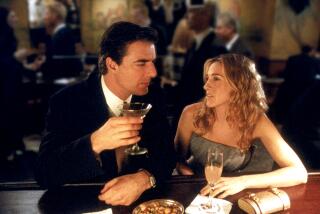Dangerous ‘Carrie’ remake sends victims of bullying the wrong message
- Share via
I know what it’s like to be Carrie White, the titular pariah in the classic horror film “Carrie.” I used to be her. In middle school, I was the kid who sat by himself at lunch, listening to my CD player or reading a book, hoping not to be noticed. I thought if I stared hard enough at the pages, I might disappear. Invisibility had its advantages. If the other students couldn’t see me, they couldn’t laugh when I walked past or whisper the nickname they had made up for me. Some time around the sixth grade, my classmates figured out that my name sounds a lot like “Dick Wang,” and every time someone pushed me into a locker or threw my backpack in the garbage, it wasn’t me they were doing it to. It was him.
For current and former teenage losers, Carrie White has become an icon, which explains her continual rebirth in pop culture. Despite the disco dressing of director Brian DePalma’s ’70s kitsch, the story of a bullied girl and her struggles to fit in is timeless. The times may change, but high school never will.
After DePalma’s 1976 original, two reboots graced the screen before Kimberly Peirce’s most recent adaptation, and arguably, “Carrie” is more relevant today than she ever has been. In the wake of the Newtown, Conn., tragedy and the wave of teenage suicides in recent years, cinema can help facilitate a discussion on youth violence and its costs. Carrie White can be born again to help us heal.
However, Peirce’s “Carrie” sends a troubling and dangerous message about teen bullying. Those familiar with DePalma’s “Carrie” will remember the climactic prom scene, in which Carrie is doused in pig’s blood by a few of her peers. Stricken by shock, Carrie imagines the crowd to be laughing at her, a projection of the mockery she has internalized. Instead, her peers stand in horror, unable to process what has happened to their prom queen. They share her shock, which makes Carrie’s subsequent revenge all the more tragic. She’s been so damaged that she can’t understand what love and empathy look like.
The new “Carrie” strips out the original’s emotional subtext by making Carrie’s imaginary violence real. Throughout Peirce’s movie, the other students relentlessly torment her, and she can’t walk down the hall without being ridiculed or stared at, as if this were “Lord of the Flies.” The overt evilness of her peers’ behavior leads to a grim shift in the film’s climax. As Carrie attends her prom, the other students whisper about her presence, continuing to make her into a spectacle. This time they are all in on the joke rather than the prank being the work of a couple of bad apples. In Peirce’s version, the audience is actually laughing at Carrie, which changes the tone of the film entirely.
Most slasher movies treat teens like meat for the slaughter, but the original “Carrie” was just as much a tragic coming-of-age drama as a horror movie. However, it’s not a tragedy anymore. It’s a revenge flick in which the villains deserve what’s coming to them. As Carrie uses her telekinetic powers to destroy the prom and kill everyone around her, the camera relishes in the mass suffering -- watching it all burn to the ground. In the original film, most of Carrie’s vengeance is implied and takes place off screen. But Peirce intimately shows you every kill as life drains from their severed torsos like a Quentin Tarantino blood opera. Carrie’s antagonist, Chris, meets her fate as Carrie sends her through a windshield, slowly dying in close-up as her wide eyes blink for the last time.
The new Carrie White becomes an Old Testament God doling out punishment to her flock, commanding her supernatural powers. Sissy Spacek, who played the original Carrie, was too angelic to be present at the genocide before her, and as the darkness took over her body, there appeared to be no one home. If anything, DePalma’s “Carrie” was a meditation on our fear of the female body, and just as Carrie doesn’t understand her cycle, she couldn’t control her gift. No one taught her how. Chloe Grace Moretz, who plays this new Carrie, however, smiles as the flames grow around her and the guilty meet their eternal reward. Now fully in control of her body, this retributive violence oddly echoes her mother’s fundamentalist extremism. Mrs. White is a religious zealot who would rather lock her daughter away than allow her to socialize.
If Carrie White is a product of her environment, Peirce’s solution offers a sadistic message for those who share the situation. Peirce tells the Carries of the world that it gets better when you kill everyone around you, as if the movie were strangely pro-school violence. Peirce means to make a cautionary tale, like “Fatal Attraction” for school bullies, but her own zero-tolerance policy looks a lot like a final solution.
No film can offer all the answers for our school violence problem, but a responsible film doesn’t pour gasoline all over the problem and light a match. The world is a worse place with movies like this in it, just as reprehensible and evil as Carrie’s peers. And by making Carrie into just another bully, the remake offers little consolation to the Carrie Whites of the world.
ALSO:
Nov. 22, 1963: 50 years, and still no conspiracy
There’s no reason, or excuse, for blackface Halloween costumesNico Lang is a contributor at Thought Catalog and co-editor of the “BOYS” anthology series. His book, “The Young People Who Traverse Dimensions While Wearing Sunglasses,” was published in August. Follow Nico on Twitter @Nico_Lang.
More to Read
A cure for the common opinion
Get thought-provoking perspectives with our weekly newsletter.
You may occasionally receive promotional content from the Los Angeles Times.









